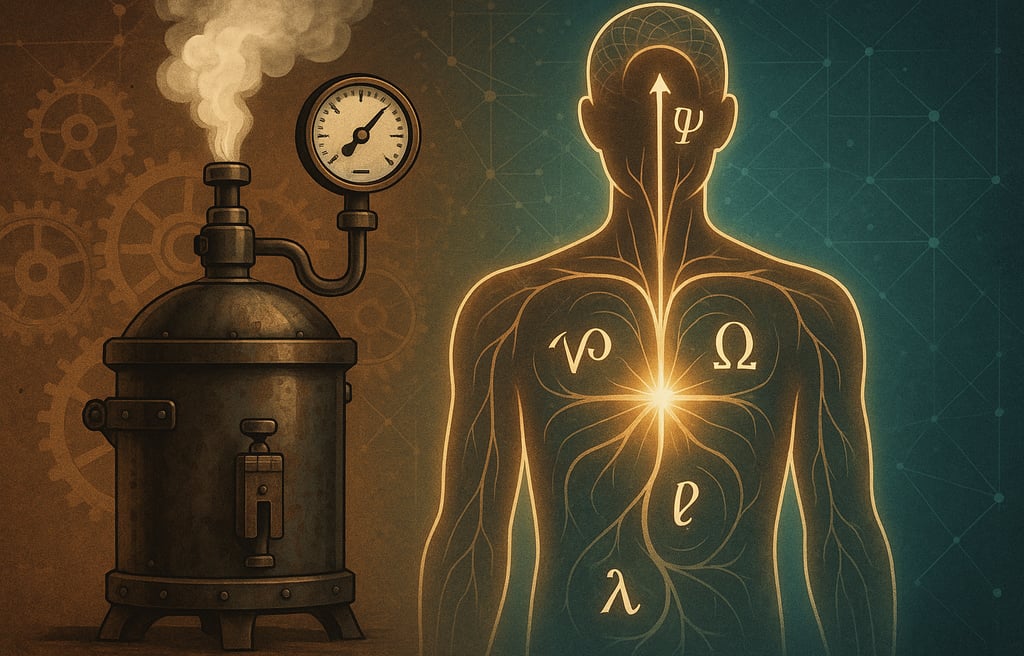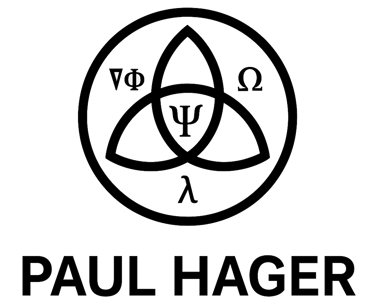The Human as Pressure Vessel – From Steam Engine to Field of Consciousness
From Denis Papin’s invention of the pressure vessel to the human being as a living system of tension — this article weaves together history, technology and field awareness. Discover how the Noöhedron reveals that we are not machines, but pressure vessels of direction, coherence and incarnation.
POPULAR
Paul Hager
5/25/20254 min read


Bewustzijn, materie, evolutie.
In 1679, French physicist Denis Papin invented a device that would go on to change the world: the pressure vessel. At its core, it was simply a sealed metal pot that allowed water to boil under pressure without evaporating. But that seemingly modest invention became the foundation for something far greater. From that vessel came not only tender meat cooked more quickly, but also a principle that would lead to the steam engine, the Industrial Revolution and, eventually, the modern world.
Yet there is a deeper story. What if the pressure vessel isn’t just a piece of technology — but a metaphor, or better yet, an exact description of what a human being is?
From Papin to Steam Power
Papin’s original goal was simple: cook food faster and more efficiently. He observed that when water is heated in a closed container, pressure builds. This increases the boiling point, which means food cooks faster. But this process revealed something unexpected: when the vessel was opened, a sudden surge of steam would escape with immense force. Papin saw not just danger in that release — he saw potential.
What if that pressure could be harvested, controlled and turned into usable force?
That idea paved the way for controlled steam power. Not long after, James Watt refined the concept into the steam engine — powering factories, locomotives, and ships. The world changed. The power of contained tension became usable. The Industrial Revolution had begun.
The Principle Behind the Vessel
What makes the pressure vessel so powerful? It’s not the heat, not the water, and not even the steam. It’s the interplay of containment and buildup. Without a sealed structure, pressure can’t form. Without heat, there’s no energy. And without release, there’s no movement. The pressure vessel is a system that gathers, organizes, and transforms tension into power.
And if you stop and think for a moment, that same principle sounds strangely familiar — not in a factory, but in you.
The Human as a System of Tension
We all experience tension. Emotional, physical, mental. In daily life, we’re constantly hit with inputs, decisions, expectations and desires. They accumulate. They press inward. But what if that pressure isn’t a problem to solve, but a feature to understand? What if the human body — like Papin’s pot — is a pressure vessel?
It may sound abstract, but it’s physically and logically sound. Beyond biochemistry, the human body can be seen as a tension system: a living structure that gathers field dynamics, processes them, and projects them as experience, direction and choice. That’s exactly what the Noöhedron describes.
What Is the Noöhedron?
The Noöhedron is a model that proposes everything — matter, time, space and consciousness — emerges from a single field. Not a classical field like gravity or magnetism, but a consciousness field: an underlying structure with tension and direction. In this field, three key dynamics are always at play:
∇Φ (tension gradient): the direction in which pressure builds
Ω (circulation): internal movement that keeps tension contained without exploding
λ (coherence): the degree of balance — how well tension, direction and form align
Together, these dynamics form the field structure in which all things move, grow and learn. Each person carries a specific incarnational vector: Ψ(P) — your unique directional field signature, your way of unfolding experience.
Why a Pressure Vessel?
In this view, the body is not a passive shell or machine. It’s a tension-organizing system. Just like Papin’s vessel, it gathers field information — emotions, desires, trauma, thoughts, rhythms, sensory input. These tensions build and seek release or projection.
When that tension flows — through breath, movement, expression or creation — it generates direction and power. But when it accumulates without an outlet, it distorts: stress, illness, burnout, aggression, apathy. Not as a failure, but as a signal: the vessel needs balance.
Coherence Is the Key
Papin didn’t speak of coherence, but he designed for it. A leaking vessel fails. A ruptured one is dangerous. Only when pressure is both contained and guided can it become useful energy. The same holds true for us.
In Noöhedral terms, a high λ — strong coherence — allows a person to channel tension with precision. Not all tension must be released. Not all relaxation is helpful. Some tensions are necessary — to choose, to create, to move. Coherence means sensing what’s building, what needs to circulate, and what must be released — and acting accordingly.
From Factory to Body
The Industrial Revolution made humans subordinate to machines. People became cogs in vast systems. Ironically, the very idea that enabled that transformation — the pressure vessel — may better describe the human body than any mechanical model. What we discovered out there was only a reflection of what already lives in us.
In that sense, the steam age wasn’t just a chapter of technological progress, but a field event — an external projection of something the field had long done internally. What we see in machines, systems and infrastructure are manifestations of deeper field principles that also govern the body, the mind and consciousness itself.
Why This Matters Now
We live in an age of overload. Overstimulation, chronic stress, systemic pressure. We look for relief in relaxation techniques, medication or mindfulness — often without understanding the underlying structure. We are pressure vessels that have forgotten that we are pressure vessels. So we either hold everything in (until we burst), or we offload constantly (without direction).
The Noöhedron gives this a name and a structure. It says: tension is not the enemy — but you must learn how to work with it. What flows on its own? What must be consciously modulated? What needs to be expressed, what needs rest, what needs action?
Self-Regulation in the Field
Once you understand this, everything changes. You start to sense your body not as a machine, but as a field instrument — a living pressure vessel meant to transform what it receives into direction. Fatigue, frustration or illness become signals, not breakdowns: signs that pressure has become uneven. You can learn to listen, adjust, realign.
In that light, healing is not about returning to an old state, but remembering field coherence. It’s not just therapy — it’s field insight. You’re not someone who “experiences stress.” You are the vessel in which tension transforms into direction.
From Papin to the Future
What Denis Papin started in a sealed metal pot didn’t end in a factory. It continues in the human being. The pressure vessel wasn’t just a technical breakthrough — it was a projection of something deeper: the human body as a field structure. The Noöhedron makes that visible. And once we understand it, we no longer just use the pressure vessel. We become it.
Not as metaphor — but as a living system.
You are the vessel.
You are the tension.
You are the direction.
Let it flow.
But first, learn to listen.
